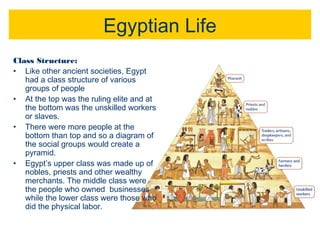Why was this region called the Fertile Crescent?
Answer must define fertile (re: land/farming) and the crescent shape of this region (may describe more)
What is the Book of the Dead and why is it used?
The Book of the Dead is a collection of spells that explains what the soul should do in the afterlife. Egytians used this to learn what their souls would do when they died.
Why the was invention of the calendar important?
Egyptians used the calendar to measure time, predict flooding, and manage the annual farming/harvest seasons. Answer might also mention the hours, days, years structure they used. Answer might also infer that Egyptians used the calendar to keep track of dates and events that they recorded.
Which two groups had the least power in the Egyptian social structure?
Slaves and farmers.
Describe the locations (and meanings) of Upper Egypt, Lower Egypt, and the Nile Delta.
Upper Egypt is upstream on the Nile River and south. Lower Egypt is downstream and north. the Delta where the Nile divides into multiple smaller rivers (in a triangular shape!) and opens out into the Mediterranean Sea. May mention that the delta region is especially fertile compared to the rest of the desert-surrounded Nile River.
What was mummification and why did Egyptians do it?
Mummification is the preserving of dead bodies so they dont break down or decay. Egyptians did this because because they believed the soul would want to use its body on eternity.
Describe at least one type of Egyptian art from the class materials OR our museum visit!
More than one type of correct answer! May describe sculpture, reliefs, jewelry, manuscripts, death masks, sculptures, or other things.
What did artisans do? Define with some examples/details.
Artisans are craftspeople who make things. Examples of these crafts include pottery, painting, carpentry, jewelry making, weaving, metalwork, leatherwork, etc.
Why were deserts important to Egypt's survival?
Deserts surrounded Egyptian societies on the Nile on both sides. These large and arid (dry) deserts would stop many enemies from traveling and attacking.
Who were the pharoahs? Define their social role and give one specific example!
Pharaohs were the supreme leaders of Egypt; they were considered to be gods as well (may share other facts and details). Examples include Hatshepsut and Ramses. Both of them led powerful armies, built impressive structures, and funded inventions/art/trade/etc.
How did Egyptians use hieroglyphics and papyrus? (Define both and explain the significance)
Hieroglyphics are a pictographic writing system. Papyrus is a kind of paper made of reeds (a water plant!). Egyptians used these to write and keep records (may give specific examples!).
What kinds of materials did ancient Egyptians trade? (name at least two)
Correct answers include: gold, papyrus, linen, and grain for cedar wood, ebony, copper, iron, ivory, and lapis lazuli
How did Egyptians use their river environment to develop a farming society?
The answer should explain how the river flooded regularly, providing silt that fertilized the soil, which made the land good for farming... answer may also describe (1) how Egyptians developed irrigation to manage the water floods and droughts and (2) other benefits of river water for cleaning, drinking, transportation by boat, fishing, etc.
What were Egyptian priests' responsibilities like?
Answer should include some or all of the following: Priests took care of the temples and performed religious ceremonies. These temples included an inner sanctuary room where statues of gods were housed. Priests had to train for many years; they were also doctors, healers, and astrologers for their community.
What was Egyptian architecture like? Describe Egyptian building styles and/or construction technology that they invented.
Answer should explain pyramids, obelisks, and/or temples. Answer may also explain the technology to quarry and transport stone, the ramp and lever, large-scale labor, etc.
How was the Egyptian social structure organized? What do you imagine it would be like to live there?
Answer should describe a version of this social pyramid and define some of the terms/roles 